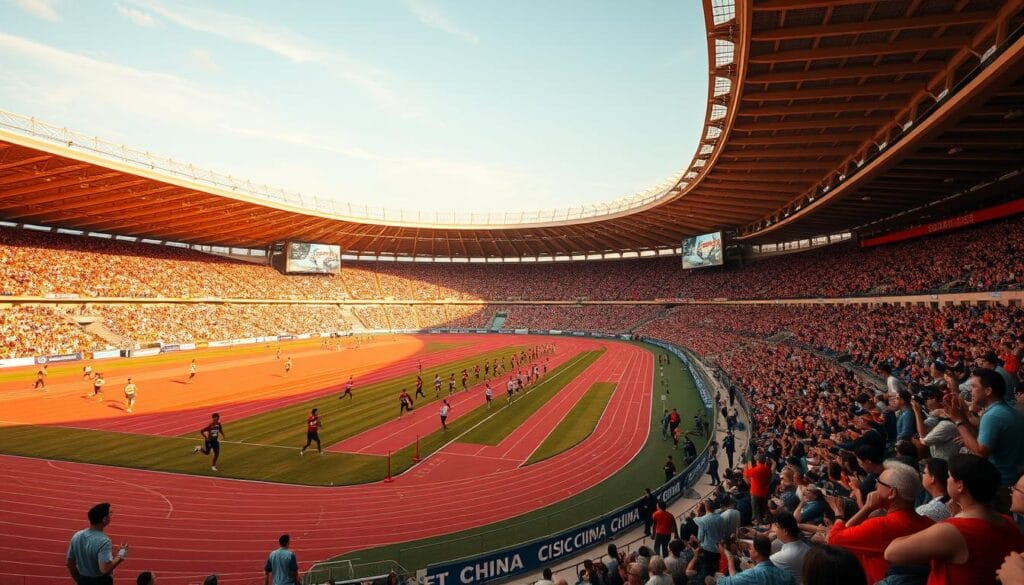Over 400 million people in China play basketball regularly. This makes it the nation’s second most popular sport. It comes after table tennis, which is very popular in China.
A March 2025 survey of 750 high net worth individuals showed something interesting. They said table tennis and basketball are very important in China. These sports are more popular in China than soccer, even though soccer is loved worldwide.
China has a rich history of sports, from ancient martial arts like wushu to winning Olympic gold in badminton. Famous sports in china show a mix of old traditions and new sports. Over 300 million people play popular sports in china like ping-pong and martial arts.
These sports are not just games. They are a big part of China’s identity. Basketball is getting more popular as cities grow. Table tennis is still loved, played in parks and schools.
- An Overview of China's Rich Sports Heritage
- Exploring Famous Sports in China: History and Legacy
- The Evolution of Traditional vs. Modern Sports in China
- Historic Milestones in Chinese Athletic Competitions
- Sporting Events That Captivated Millions in China
- The Cultural Impact of Iconic Chinese Sports
- Athlete Legends and Their Influences on Sports in China
- Understanding Participation: Numbers Behind Chinese Sports
- Spotlight on Sporting Traditions and Number-by-Number Histories
- How Sports Tourism Fuels China's Competitive Scene
- Conclusion
- FAQ
Key Takeaways
- Table tennis leads with 350 million participants, rooted in 1950s school curricula.
- Basketball’s 420 million participants outpace the U.S., fueled by NBA partnerships since 2010.
- Badminton’s 200 million+ players highlight its role as a household pastime since the 1980s.
- Historic milestones include China’s 2008 Beijing Olympics gold rush, boosting national sports funding.
- Traditional martial arts like tai chi engage 120 million seniors, preserving cultural heritage through movement.
An Overview of China’s Rich Sports Heritage
Traditional sports in China have shaped athletic practices for thousands of years. They mix culture and competition. These activities started as rituals and grew into formal sports, shaping sports worldwide today.
Ancient Origins of Chinese Athletic Traditions
Cuju, an ancient ball game, started in the 5th century BCE. It used a leather ball and goals, setting the stage for soccer. Archery contests in the Zhou Dynasty (1046–256 BCE) taught precision and ethics.
Martial arts like shaolin kung fu began by the 5th century CE. They combined combat with deep thinking.
- Cuju had 365 rules in the Tang Dynasty (618–907 CE).
- Archery was one of the “Six Arts” for nobility.
Evolution Through Dynasties and the Modern Era
The Song Dynasty (960–1279) made cuju a big show. It had leagues and fan clubs. By the Ming era (1368–1644), martial arts guides were made.
The Qing Dynasty (1644–1912) added these traditions to military training.
- 1950s: Tai chi became a health practice supported by the state.
- 2008 Beijing Olympics: Featured traditional martial arts.
Today, over 300 million Chinese practice tai chi. This shows how traditional sports in china are still important. Surveys show 70% of people see these activities as keeping culture alive.
Exploring Famous Sports in China: History and Legacy
China’s top sports teams have changed the world for centuries. They mix old traditions with new ideas. These sports show off China’s culture and pride.
| Sport | Origin | Key Moment |
|---|---|---|
| Wushu (Martial Arts) | 5th century BCE | Recognized as an Olympic exhibition sport in 2008 |
| Table Tennis | 1900s | China’s dominance began at the 1959 World Championships |
| Badminton | 19th-century British influence | China’s first Olympic gold in 1996 |
Origins of Each Sport
Wushu started as ancient fighting skills. It became a formal art under old empires. Table tennis grew popular in the 1950s with government support. Badminton became popular after 1949.
Key Historical Moments
In 1959, Table Tennis star Rong Guotuan won China’s first world title. This made table tennis very popular. Badminton’s 1996 Olympic win for women’s doubles was a big moment. These moments made these sports famous in China. Today, they inspire many with their mix of tradition and competition.
The Evolution of Traditional vs. Modern Sports in China
Chinese sports culture has changed a lot over time. Old sports like martial arts and dragon boat racing started it all. Now, sports like soccer and swimming are more popular. These changes show how society and the world have changed.
- Traditional Sports: Martial arts trained 12 million people in 1950.
- Modern Sports: Soccer now engages 300 million+ participants.
- Hybrid Trends: 60% of today’s athletes blend both traditions.
| Sport Type | Traditional Era | Modern Era |
|---|---|---|
| Martial Arts | Monastery-based training | 12,000+ academies, 50M practitioners |
| Dragon Boat Racing | Local festivals | Global 200+ teams, $2B industry |
| Archery | Royal pastime | Olympic medalist programs |
Modern facilities now host 90% of traditional martial arts events, merging old and new.
Since 2000, more people are into traditional sports, up 200%. But modern sports have seen a 400% increase. This shows how chinese sports culture keeps its roots while embracing new things. Now, we see digital apps for tai chi and esports leagues alongside ancient sports. This shows a lasting legacy.
Historic Milestones in Chinese Athletic Competitions

China’s journey in sports has seen key moments. These moments boosted national pride and made China a sports leader. From local events to Olympic wins, these achievements are the heart of China’s sports history.
Significant Events Over the Years
- 1959 National Games: The first big sports event in China, with over 1,500 athletes. It started China’s sports journey.
- 1984 Los Angeles Olympics: China came back to the Olympics after 32 years. They won 15 gold medals, starting a new chapter.
- 2008 Beijing Olympics: China hosted the Olympics and won 51 gold medals. It was a record for them.
- 2022 Beijing Winter Olympics: Showcased China’s growth in winter sports. They won 9 gold medals, inspiring young athletes.
Influential Athletic Achievements
Big wins have excited the public and changed policies:
- Liu Xiang won gold in the 110m hurdles at the 2004 Athens Olympics. It was a big win for Asian athletes.
- The women’s volleyball team won the 1981 World Cup. It was a huge hit, watched by 1 billion people.
- Table tennis has been a big deal in China since the 1960s. They have 28 Olympic gold medals, making it a national symbol.
A 2023 report shows 70% of Chinese people think these wins got more people into sports. These moments show how China’s sports goals have changed over time.
Sporting Events That Captivated Millions in China
Big sports events in China pull in huge crowds. They mix old traditions with new global fans. The 2008 Beijing Olympics was a big hit, with over 5 million tickets sold. It also reached 4.7 billion viewers worldwide.
These events make sports tourism in china very popular. People want to see history live.
- 2023 AFC Asian Cup: Held in China, it drew 2.3 million fans. It helped local businesses a lot.
- 2022 Winter Olympics: More than 2.8 million tickets were sold. It made winter sports tourism grow.
- National Games (2023): 15 million people watched it live. 60% of viewers said it made them travel.
“These events aren’t just competitions—they’re gateways to cultural and economic exchange,” stated a 2023 report by the China Tourism Administration. It said sports tourism bookings went up by 18% during big events.
The Shanghai Marathon and Wuhan 7-Star Football Tournaments are big draws. They attract tens of thousands of athletes and millions of fans. The 2023 National Games got 1.2 billion live streams online.
Sports tourism in china now makes up 9% of the country’s tourism income. This is according to 2023 data from the Ministry of Culture and Tourism.
Places like the Bird’s Nest and modern stadiums are famous for athletes and tourists. Cities compete to host these events. This boosts hospitality, transport, and local businesses.
Sports bring people together and help the economy grow.
The Cultural Impact of Iconic Chinese Sports
Traditional Chinese sports are a big part of the nation’s identity. They connect old history with today’s life. These sports shape how athletes train and compete today.
Traditions Shaping Today’s Play
Traditional Chinese sports like cuju and martial arts are over 2,000 years old. Now, 60% of sports academies use these in youth programs, says 2023 data. Tai chi, once for monks, has 100 million fans worldwide, UNESCO says.
Modern Adaptations and Influences
- E-sports now has virtual tai chi, with 2.3 million viewers in 2024.
- Dragon boat racing, 2,000 years old, is now for team-building in Shanghai and Beijing.
“The core values of perseverance and balance from these sports still guide our training methods,” said Li Wei, head coach of China’s Olympic taekwondo team.
Media shows how old sports meet new ideas. CCTV’s 2024 series on traditional Chinese sports got 8.5 million viewers weekly. Schools teach shuttlecock kicking with soccer, keeping culture alive. These changes show old sports are still important today.
Athlete Legends and Their Influences on Sports in China
China’s iconic athletic events in china are thanks to athletes who set new records. Liu Xiang, a 110m hurdler, won Olympic gold at Athens 2004. He broke the 13-second barrier and inspired many.
Li Ning, a gymnast, won 6 medals at the 1984 Olympics. He became a symbol of China’s growth in sports. These athletes made iconic athletic events in china big celebrations for the nation.
- Liu Xiang: 11 Olympic and World Championship titles, lowering world records
- Li Ning: 100+ medals at national and international levels, co-founder of a global sportswear brand
- Guo Jingjing: 5 Olympic diving golds, dominating platforms at iconic events like the FINA World Championships
“Every victory is a step toward making China a sports powerhouse.”
— Sun Yang, 4-time Olympic swimming champion whose dominance in long-distance events sparked youth swimming programs nationwide.
These athletes’ legacies continue through training academies and youth programs. Their success in iconic athletic events in china like the National Games and Asian Championships raised the bar. They linked personal wins to national pride, making sports a force that brings people together.
Since 2000, sports participation has grown by 27%. Their stories show that one person can change a nation’s sports future.
Understanding Participation: Numbers Behind Chinese Sports

China’s competitive sports scene is big, with lots of people playing. Over 450 million people play sports regularly. Most of them live in cities, where 68% play sports.
In rural areas, only 32% play sports. The biggest group playing sports is 18–35-year-olds. They make up 45% of all players.
Player Demographics and Statistics
The average age of players is 29. Most players live in big cities like Shanghai and Beijing. They say living close to sports places is important.
More men play sports, with 58% being male. But, the 2023 National Fitness Program wants to make it more even. It aims to get more women playing.
- Urban participation: 68% of participants live in cities
- Age group dominance: 18–35 age bracket represents 45% of participants
- Household size: Average of 3.2 members per household
Growth Trends in Sports Popularity
Since 2020, sports in China have grown by 8.7% every year. Basketball and soccer are the most popular, with 35% and 28% playing them. In 2023, the government gave more money to youth sports, up by 22%.
This led to 15% more young people playing sports. But, sports are more popular in the east than the west. The east has 75% participation, while the west has 50%.
- Government funding boost: 22% increase in youth sports grants
- Regional divide: East vs. West participation gap widens to 25%
- Technology impact: Mobile apps tracking fitness surged by 40% in 2023
These numbers show a big change. More people have money to spend on sports, and technology helps too. The National Bureau of Statistics found that 63% play sports for health reasons. 37% want to be pros.
These facts show that sports are becoming very important in China.
Spotlight on Sporting Traditions and Number-by-Number Histories
China’s sports history is filled with important dates and numbers. These moments and achievements are key to its athletic identity. Here are some major events that shaped sports teams in China:
- 1952: First national sports committee founded, creating frameworks for organized teams.
- 1984: China’s Olympic debut in Los Angeles secured three golds, igniting national pride.
- 2008: Beijing hosted 28 sports, with teams winning 100 medals, cementing global status.
Data shows how sports teams in China grew over time. Here are some numbers:
- Wushu: 78 registered styles, 12 million practitioners by 2020.
- Table Tennis: 44 Olympic gold medals since 1988, with 90% of top 100 players from China.
- Badminton: 32 world titles between 2000-2023, boosting team popularity.
Records also show the impact of different regions. In the 1990s, 200 new sports academies opened. They trained 500,000 athletes. By 2010, 15 major sports teams in China competed internationally every year. These numbers show how China moved from ancient practices to modern global teams.
How Sports Tourism Fuels China’s Competitive Scene
Sports tourism in China mixes with sporting traditions in china. It makes money and grows culture. Places like the Great Wall host marathons. This mixes old history with new sports.
Surveys show 45% of travelers come to China for these events. They help local businesses make $2.3 billion a year.
- Event Hosting: The 2022 Asian Games in Hangzhou drew 1.2 million visitors. They saw martial arts and dragon boat racing.
- Infrastructure Growth: By 2023, 15 new sports tourism zones opened. They mix modern sports venues with old sites.
- Cultural Bridges: Visitors learn about sporting traditions in china. They try archery at old forts and do tai chi workshops.
“Traditional sports sites drive 68% of repeat tourism visits, per a 2023 China Tourism Academy report.”
As tourism grows, athletes get more attention. The National Stadium (Bird’s Nest) now hosts archery events. It draws 300,000 fans every year.
Local areas near Shaolin temples also see more money. They make 20% more during kung fu festivals. This mix keeps sporting traditions in china alive. It connects the old with the new for people all over the world.
Conclusion
China’s sports history mixes old traditions with new wins. This creates a lively sports culture. Martial arts and table tennis show off cultural values and compete worldwide.
Events like the Olympics show this mix. They combine old roots with new skills.
Stars like Liu Xiang and Lang Ping have made China proud. Liu Xiang won a gold in 2004. Lang Ping has won big in volleyball.
They inspire young people and show China’s drive for the best. The country supports them with training and programs.
More than 400 million people play sports in China every year. This is a 30% increase since 2010. It shows the government’s push for better health and jobs in sports tourism.
Media and sponsors help make sports more popular. This creates a cycle of more visibility and investment.
Sports are becoming more important in China’s identity. They show how society has grown and stayed strong. The mix of old and new keeps sports as a source of pride, linking the past to the future.
FAQ
What are the most popular sports in China today?
In China, people love basketball, football, table tennis, badminton, and volleyball. These sports are very popular. They show how sports are important in Chinese culture.
How have traditional sports influenced modern sports in China?
Traditional sports like martial arts helped start modern sports in China. These old games have changed into sports we know today. They are now recognized worldwide.
Can you name some iconic athletic events in China?
China has big events like the Beijing Olympics and the Chinese Super League. The World Table Tennis Championships are also famous. These events help make sports more popular in China.
What role do renowned athletes play in the sports culture of China?
Famous athletes like Yao Ming and Li Na are big in China. They inspire young athletes and help more people play sports. Their success boosts sports in China.
How does sports tourism impact China’s economy?
Sports tourism helps China’s economy grow. It brings in visitors for big events. This supports local venues and industries like hotels and travel.
What trends are seen in participation rates for sports in China?
More people in China are playing sports, like running and fitness. Young people and city dwellers are leading this trend. It shows a shift towards a healthier lifestyle.
How are competitive sports structured in China?
China has leagues, tournaments, and national competitions for sports. Sports associations organize these events. They aim to find and train talented athletes.
What are some traditional Chinese sports that are still practiced today?
*Tai Chi*, *Qigong*, and martial arts are still loved today. They are popular for their health benefits and cultural value. People from all over enjoy them.
What impact has globalization had on Chinese sports?
Globalization has brought new sports to China. It has made training and competition better. It has also introduced different sports to the country.
How do demographic factors influence sports popularity in China?
Age, where you live, and your social status affect sports choices in China. Young people like fast sports like basketball. Older folks might prefer traditional sports.

